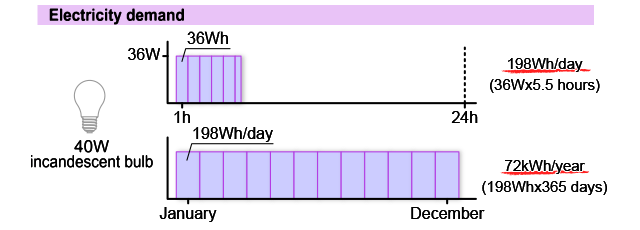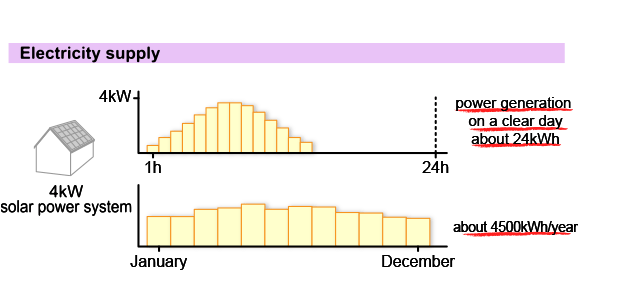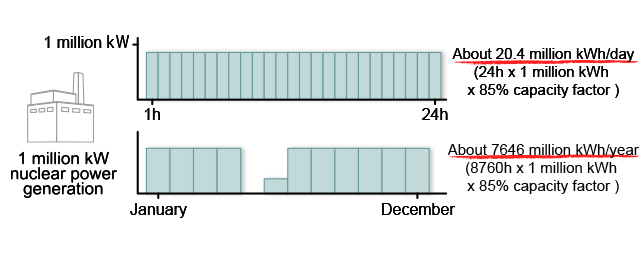Watt (W) vs. Watt-hour (Wh)
When considering electricity issues, to understand a difference between Watt (W) and Watt-hour (Wh) is important.
● W=a unit of power, the rate at which energy is generated or consumed 1000W=1kW(kilowatt)
● Wh=a unit of energy, the total amount of energy generated or consumed 1000Wh=1kWh(kilowatt hour)
Amount of household electric energy usage
Household electricity consumers will receive monthly electricity bill issued by the power company.
The value of electricity consumption amount is indicated in the unit of kWh, and electricity charge is corresponding to the amount of electricity consumption during that month. 1000Wh (1kWh) electricity usage is equivalent to the 1 hour usage of electric appliance consuming 1000W (1kW) electricity.

*Assumed the annual lighting time 2000 hours and daily lighting time 5.5 hours. Refer to Residential and commercial sector in 'Is energy used efficiently?'

*Using the value of viewing time 4.5 hours and standby time 19.5 hours per day, power consumption of viewing is estimated from annual power consumption. Refer to Residential and commercial sector in 'Is energy used economically?'
Capacity factor of power plants
Here we estimate a value of power generation in kWh
When a nuclear power with 1 million kW rated capacity (installed capacity) is operated throughout one year (8,760 hours), the amount of annual power generation is 8760 million kWh, which means the annual capacity factor is 100 percent.
In fact, however, power plants never operate without cease because they periodically shut down for inspection.
Therefore, the capacity factor of a power plant is the ratio of its actual annual output (numerator), to its calculated annual output presuming it operates throughout the year at is rated capacity (denominator).
In other words, the capacity factor indicates the value of how much the equipment of each power plant is utilized.
(Before The Great East Japan Earthquake, capacity factor of Japanese nuclear power plants is around 60 to 70%, which is significantly low compared to 85% of the world average.)
Based on the principle of economic operation in power generation in terms of fuel cost, nuclear and coal power plants operate continuously (high capacity factor), on the other hand oil power plants whose fuel cost is expensive operate only at the peak of power demand.
However, the renewable power generation does not fit this principle.
Rooftop solar panels with 4kW rated capacity, for example, output 4kW only when it is exceptionally sunny at daytime and the output will be zero at night. In case of Japan, the annual average capacity factor of solar panel is small, about 12% in track record. As a matter of course, capacity factors of such natural energy-based power generation including wind power, will be determined by natural conditions.
Fukushima Daiichi nuclear plant rated at capacity 4.7 million kW in total and the calculated annual power generation capacity is 35 billion kWh at 85% capacity factor. It is discussed to replace this with renewable energies, but setting up the solar cell rating at capacity 4.7 million kW can actually generate only 4.94 billion kWh (12% capacity factor). For the complete replacement, solar cell rating at capacity 33 million kW (about 7 times) is required and also the footprint for setting up solar cell is enormous.

Annual electric generation is estimated from the catalog value of the 4kW ~ 5kW solar power system of major manufacturers
Changes in the graph show an image

Changes in the graph show an image. A reactor is usually shut down over a period for a regular inspection.
Supply and demand balance of power
kW is a unit to represent the amount of the instantaneous power. Electric power companies must balance supply and demand amount instantaneously on the basis of kW when the demand for power occurs.
The voltage and frequency in power grid change if only 1- or 2-minute imbalance in demand and supply happens. And a lot of machines run depending on frequency and even 1Hz of frequency change makes some machines difficult to continue its operation. For example, in the textile industry unevenness is caused in the product due to the fluctuation of frequency.
Therefore, power plant are operating so that the frequency is kept stable, while predicting instantaneous power demand which is susceptible to various factors such as the time season, weather, temperature, or day of the week. For example, during the lunch break time in weekdays, many plant machineries also take a break and power demand decreases accordingly, therefore power plants prepare for restraining power generation to adjust output before noon. Before lunch time is over, power plants adjust the output to increase the amount of power generation again.
It is necessary to understand that, when large amounts of electricity is supplied from renewable energies like solar or wind that fluctuate according to natural conditions, grid operation with well-balanced supply and demand requires more adjustment in accordance with the fluctuation.








